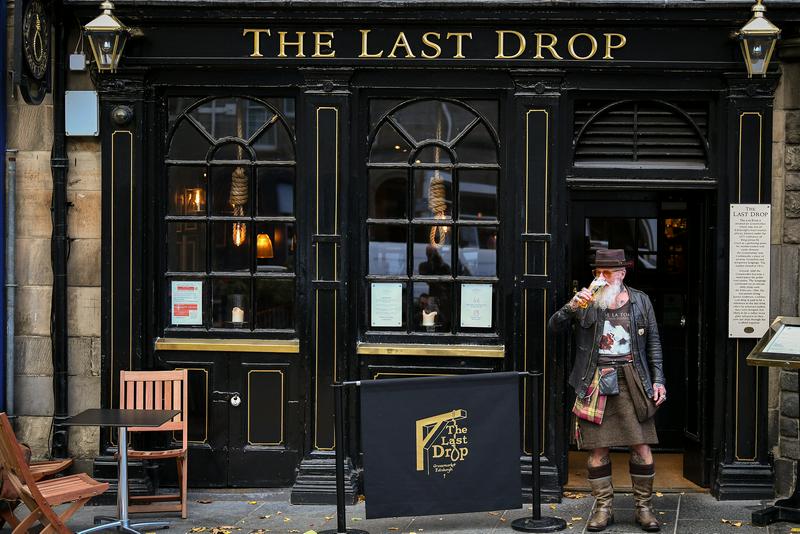A History Of Tavern Names And Their Clever Wordplay
By | March 16, 2021

The White Hart, the Pig N' Whistle, Ye Old Fighting Cocks: Whether it's the liquid courage or the desire to stand out from the crowd, it seems that pub owners have no trouble using inventive and often humorous names and signs to hang over their fine establishments. But have you ever wondered why so many tavern names include such colorful imagery, very often having little to do with actual products being sold (you know, alcohol)? It turns out there's actually a rich history behind these wild and whimsical symbols.

In Christ We Drink
The earliest drinking establishments in England were actually connected to the Catholic Church, as inns began popping up around the country to give shelter to the traveling clergy. Ye Olde Trip to Jerusalem in Nottingham boasts itself as the oldest pub in England, claiming to have been in service since 1189 for pilgrims seeking to join the Crusades back in the Middle Ages. Perhaps even older, however, is the pub of Ye Olde Fighting Cocks in Hertfordshire, which was supposedly connected by underground tunnels to the old St. Alban's Cathedral so that monks could safely pass back and forth to the wine cellar. Sadly, the tunnels don't appear to exist anymore, if they ever did.
Unfortunately, there's too little concrete evidence for historians to be sure which actually came first, but religious underpinnings are definitely apparent in many establishments of yore, which often featured images of a lamb, a common symbol of Christ. In fact, since the vast majority of the English population was illiterate during the Middles Ages, symbols on signage was kind of imperative, especially after a law was passed in 1393 mandating their use to help passersby better recognize what kind of venue they were entering. This was already a common practice in places like Rome, where vines were hung outside doors and over signs to indicate that wine was available, but as England is better known for beer, they used the evergreen hollybush as enticement.

Monarchs And Mash-Ups
Christian imagery fell to the wayside under the rule of King Henry VIII, who famously broke from the Catholic Church, and pubs instead adopted a more nationalistic, monarchical approach to their naming. Crown symbols started popping up everywhere, and suddenly, you couldn't throw a cobblestone without hitting some pub called King's Head This or Duke's Arms That.
There were also slightly more subtle trends in tavern names, like the imagery of the lion (which has symbolized English monarchy since King Henry I) and the proliferation of White Hart taverns (a nod to King Richard III, who was often represented as a white deer wearing a golden chain). Meanwhile, the Oak Tree alludes to the true story of Prince Charles II, who survived his run-ins with the Roundheads during the English Civil War by hiding in the branches of a tree as his foe tread the ground just beneath him. In addition to the King's Head, you'll also run into many Queen's Head taverns around England, but you won't get a glimpse of the current Queen Elizabeth on any signage. In Her Majesty's realm, it's considered deeply inappropriate to depict a living monarch on any pub's sign.
Where the real fun begins is when pub owners began to pay homage to King Henry VIII's love of hunting. Any pub located near a popular hunting area tried to appeal to the market with names like the Bird in Hand for falconers or the Hare and Hound for rabbit hunters, while others took the lazy route and simply paired a random object with an animal, which is how we got Bournemouth's Goat and the Tricycle and Manchester's Ape and the Apple.
Other times, however, the animal imagery was more of an accident. Low literacy rates meant that names changed as people communicated over time, like when the St. Catherine's Wheel pub that once paid respect to the martyr became known as the Cat and Wheel over time due to essentially a very long game of telephone. Other examples of this etymological breakdown include the Bacchanalians, which became the Bag of Nails, and Pique et Carreau, which became the Pig and Carrot. Hey, it's hard enough to speak French when you're sober.

Cock And Bull Stories
Although language often changed the names of pubs, the opposite was sometimes true as well. During the 18th century, two travelers' taverns stood across the street from one another, the Cock on one side and the Bull on the other. It is said that coach drivers would chat with each other on the street between them, relaying whatever crazy thing they'd seen on their most recent travels to the other coachmen. Sometimes, their tales were so grandiose as to be unbelievable, which is thought to be the origin of the common English idiom, "a cock and bull story."
Many try to evoke powerful associations of kings and popes, but some tavern owners have been inspired by more shady figures, like the gentlewoman-turned-highway-robber Lady Katharine Ferrers. As the legend goes, the Lady fell on hard times after the death of her husband and took up robbing travelers while dressed like a man to make some fast cash. She turned out to be pretty good at it, but eventually, her crimes caught up with her and she was fatally shot in Wheathampstead, where today the Wicked Lady Pub stands in her (dis?)honor. Likewise, while the Lamb and Flag pub in London, a favorite of literary giant Charles Dickens, still holds its official name, which is a nod to both Christ and the Flag of the Knights Templar, many locals simply refer to it as the Bucket of Blood, thanks to the truly impressive number of bar and prize fights that have occurred there over the centuries.

